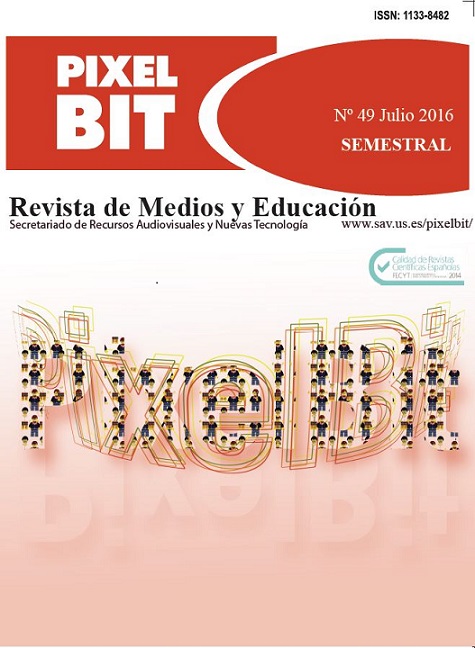Resumen
En este artículo se presentan los resultados de un estudio que tiene como objetivo analizar herramientas web 2.0 gratuitas para el diseño de cuestionarios on-line. El procedimiento se desarrolla en cuatro fases: (1) Identificación y localización de herramientas; (2) Definición de criterios de análisis; (3) Análisis de herramientas y (4) Análisis de resultados. Se analiza un total de 37 herramientas de las 45 identificadas. Se constata el elevado número de aplicaciones existentes con versiones gratuitas que, en general, ofrecen funciones limitadas. Aunque las características de algunas de ellas pueden ajustarse a las necesidades de los investigadores.
Citas
Alarco, J.J. & Álvarez, E.V. (2012). Google Docs: una alternativa de encuestas online. Educación Médica, 15 (1), 9-10. Recuperado de http://scielo.isciii.es/pdf/edu/v15n1/carta1.pdf. doi: 10.4321/S1575-18132012000100004
Callegaro, M., Manfreda, K. L. & Vehovar, V. (2015). Web survey methodology. Thousand Oaks, CA: Sage Publications.
Castañeda, J.A. & Luque, T. (2004). Diseños de investigación comercial en internet: oportunidades y limitaciones. Investigación y Marketing, 84, 20-28.
Chang, L. & Krosnick, J.A. (2009). National surveys via RDD telephone interviewing versus the Internet: comparing sample representativeness and response quality. Public Opinion Quarterly, 73 (4), 641-678. doi: 10.1093/poq/nfp075
Couper, M.P. (2000). Web surveys: A review of issues and approaches. Survey Public Opinion Quarterly, 64, 464-494.
Couper, M.P. & Miller, P.V. (2009). Web surveys methods: Introduction. Public Opinión Quarterly, 72 (5), 831-835.
Cuende, D. (2010). Visión global del mercado de la investigación – ESOMAR 2009. Investigación y Marketing, 106, 52-53.
De Leeuw, E.D., Hox, J.J. & Dillman, D.A. (2008). Mixed mode surveys: When and why. En E.D. De Leeuw, J.J. Hox & D.A. Dillman (eds.), InternationalHandbook of SurveyMethodology (pp.299-316). Nueva York: Lawrence ErlbaumAssociates y Asociación Europea de Metodología.
Díaz, V. (2011). Encuestas con encuestador y autoadministradas por internet. ¿Proporcionan resultados comparables?. Revista Española de Investigaciones Sociológicas, 136 (1), 49-90. Recuperado de http://reis.metapress.com/content/e537286p881328g7/fulltext.pdf. doi:10.5477/cis/reis.136.49
Dillman, D.A., Smyth, J. & Christian, L.M. (2009). Internet, Mail and Mixed-Mode Surveys: The Tailored Design Method. New York: John Wiley.
Fricker, R. & Schonlau, M. (2002). Advantages and disadvantages of internet research surveys: evidence tom the literature. Field Methods, 14 (4), 347-367.
Ganesan, P. & Kumar, D.K. (2015). Online Questionnaire in Social Science Research: A Comparative Study of Online Questionnaire Services Providers. SRELS Journal of Information Management, 52 (5), 377-383. doi: 10.17821/srels/2015/v52i5/79750
Janelle, D.G. & Hodge, D.C. (2000). Information, place, cyberspace and accessibility. En D.G. Janelle & D.C. Hodge (eds), Information, Place and Cyberspace (pp. 3-12). New York: Springer.
Kent, R. & Lee, M. (1999). Using the Internet for Market Research: A Study of Private Trading on the Internet. International Journal of Market Research, 41, 377-385.
Khode, S. (2015). Online Questionnaire for Survey Research: Comparative Study of the Features Available with Free Account of Some Selected Tools. Pearl: A Journal of Library and Information Science, 9 (2), 101-105. doi: 10.5958/0975-6922.2015.00013.3
Kreuter, F., Presser, S. & Toureangeau, R. (2008). Social desirability bias in CATI, IVR and Web Surveys. Public Opinion Quarterly, 72 (5), 847-865. doi: 10.1093/poq/nfn063
Lamas, C. (2007). The Testing Web interviewing in the EGM Multimedia Survey. Ponencia presentada en EMRO Conference 2007, en Mayo, Munich (Alemania).
López, A. (2008). ¿Seguimos hablando del online. Investigación y Marketing, 98, 28-30.
Manfreda, K.L., Bosnjak, M., Berzelak, J., Haas, I. & Vehovar, V. (2008). Web surveys versus other survey modes: a meta-analysis comparing response rates. International Journal of Market Research, 50 (1), 79-104.
Manfreda, K.L. & Vehovar, V. (2008). Internet surveys. En E.D. De Leeuw, J.J. Hox & D.A. Dillman (eds.), International Handbook of Survey Methodology (pp.264-284). Nueva York: Lawrence Erlbaum Associates y Asociación Europea de Metodología.
Mann, C. & Stewart, F. (2000). Internet Communication and Qualitative Research: A Handbook for Researching Online. London: Sage Publications.
Martín, M. & Moré, D. (2010). Las claves de la investigación on line. Investiga, 9, 6.
Sánchez, J.J., Segovia, J.M. & Sánchez, P. (2011). Las encuestas en Internet. En M. Arroyo y I. Sábada (Coords.), Metodología de la investigación social: técnicas innovadoras y sus aplicaciones. (pp.79-108). Madrid: Síntesis.
Stoop, I., Billiet, J., Koch, A. & Fitzgerald, R. (2010). Improving Survey Response: lessons learned from the European Social Survey. New York: Wiley.
Tapia, J.A. & Menéndez, J. A. (2015). Probabilistic Web survey methodology in education centers: An example in Spanish schools. Survey Practice, 8 (3). Recuperado de http://www.surveypractice.org/index.php/SurveyPractice/article/view/290/pdf_31
Valls, O. (2007). Investigación on-line: menos costes y mayor rapidez. Investiga: Publicación de Investigación de Mercados, 17, 24-28.
Warf, B. (2001). Segueways sinto cyberspace: multiple geographies of the digital divide. Environment and Planning B, Planning and Design, 28, 3-19. doi: 10.1068/b2691

